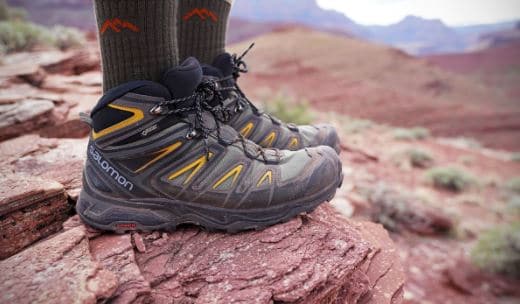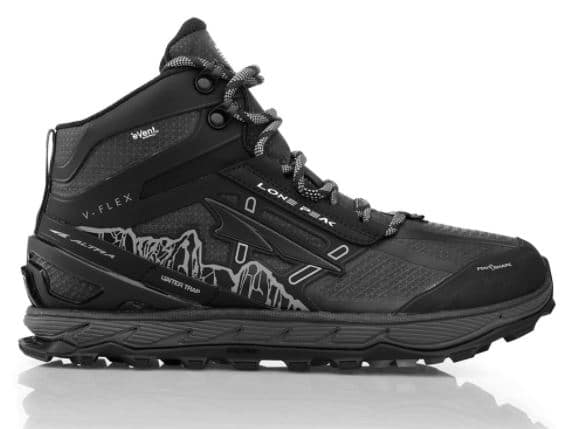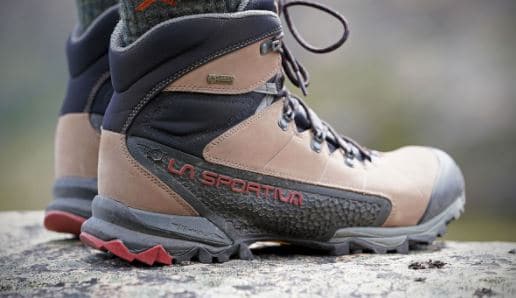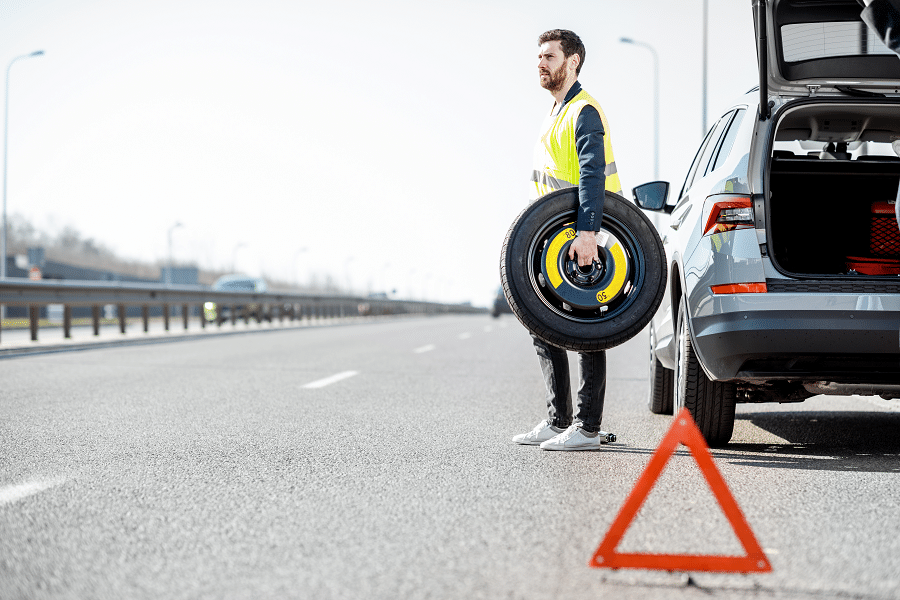The pandemic of 2020 left everyone planning an outdoor trip near nature with their loved ones. Being cooped inside one’s humble abode for almost a year demands an outdoor activity that is revitalizing, and what is better than a hiking trip with friends and family to regain lost control over life and events?
Hiking’s one of the best activities to get back on track both mentally and physically, whether it is local trails you wish on hitting or a backpacking weekend trip with mountains and waterfalls around. However, the choice of footwear for hiking can easily influence your overall experience.
Contents
- 1 How To Choose The Right Hiking Shoes?
- 2 Types Of Hiking Footwear
- 3 Hiking Shoes
- 4 Hiking Boots
- 5 Backpacking Boots
- 6 Light Weight Hiking Boots
- 7 Salomon X Ultra 3 Mid GTX
- 8 Salomon Quest 4D 3 GTX
- 9 Keen Targhee II Mid
- 10 Altra Lone Peak 4 Mid RSM
- 11 LA Sportiva Nucleo High GTX
- 12 What Makes Good Hiking Boots And Things You Must Look For
How To Choose The Right Hiking Shoes?
There is no single perfect type for hiking shoes or any shoe for that matter. The alterations and varieties are ever existent as everyone has different feet. The best tested and tried way to understand your foot build and find the right pair of shoes is to try them out before buying. One could never go wrong with trying out pairs personally and taking expert suggestions on what’s new in the market and what must suit you best in terms of use, comfort, and prior issues.
The terrain you choose for hiking, the weather conditions, activities you wish to indulge in, support your foot needs, and the foot type can significantly influence your ideal shoe type. Medical conditions like prior back or foot injuries and even issues like diabetes will require you to get custom-made shoes or orthopedic shoe inserts. The foot arch or conditions like flat-footedness can result in severe foot issues like shin splints and overpronation. Therefore, consulting a physician or an expert is your best shot at not facing foot pain and having a fulfilling hiking experience.
Types Of Hiking Footwear
Hiking Shoes

If you plan a hike to define easier and short trails, getting hiking shoes instead of boots is a good choice. They are flexible and lighter than regular shoes and boots and are made with material to withstand easy-medium rugged terrain. Different shoe versions may vary in features like being waterproof and cost depending on the same. Many professionals or regular hikers who wear shoes on longer, more challenging trails instead of boots do so because of their leg strength and experience.
Hiking Boots

Hiking boots are ideal for long, strenuous hikes with rough terrain and a fair amount of gear. They are perfect for beginners as they support ankles, feet, and heels better than hiking boots. Day hiking boots are among the most popular hiking boots, with either mid or high-cut shafts to prevent strains. Though hiking boots are typically heavier than shoes, thanks to advanced technology, brands are continually putting out models that are not only lightweight alternatives but also much durable.
Backpacking Boots

All the serious and determined hikers who prefer long trips that last days on end need to invest in a good pair of backpacking boots without fail. They might seem a little heavier and stiffer, but the insulation they provide, their tall built support, and the firm foundation are what you need while carrying loads of hiking gear for multi-day trips.
Though the boots are good to avoid weather difficulties and rough terrain, many people may find them unbreathable and more tiring than regular hiking boots or shoes. Pairing them with thick hiking socks is good for maintaining balance and support. However, most backpacking shoes have a break in time of two weeks which is a must to get them ready before starting a hike.
Light Weight Hiking Boots
Salomon X Ultra 3 Mid GTX

These are among the best and highly rated hiking boots, fitting ideal for both men’s and women’s feet types. The reason for the popularity is their high traction abilities, comfort, and good breathability than similar ones in its league.
Though made of leather with a thick Vibram outsole, the Salomon X ultras weigh lighter, contrary to what they may come off as. Another intriguing feature of the shoes is there is no break-in time, meaning you could use them right out of the box without any worries of rubbing spots on ankles or feet, even on aggressive trails and rocky lands.
Good traction makes it so that whatever the trail condition may be, such as a groomed dirt trail, loose dirt, rocks, or incline/declines, you get a balanced and comfortable walk throughout. With the Salomon X ultras, you need not worry about rocks poking your feet or toes issues, as these provide extra room to protect toes that swell up after or during a hike. The shoes are also popular for their speed lacing system, high ankle collar, firm midsole, and easy breathability, which doesn’t let them get damp even in high temperatures.
The colorway and exterior styling bothers people who wish to serve looks and comfort at the same time. The shoes, though marketed as fully waterproof, have witnessed customer complaints regarding minor leaks near toes.
Salomon Quest 4D 3 GTX

These are yet another popular backpacking boot for both women and men by Salomons, delivering comfort and protection to the hikers seeking challenges in rugged terrains and harsh environments. The boots feature an abrasion-resistant and waterproof synthetic upper and a breathable Gore-Tex membrane, readily in different sizing. These backpacking boots protect against terrain difficulties and weather and help maintain support and stability through their Contagrip outsoles and 4D advanced chassis. Both of the mentioned features improve grip on various surfaces and provide flexibility and balance on them, respectively.
These boots have special Ortholite and moisture-wicking technology, which keeps issues like foot odor and dampness away while providing a foam memory for better adjustments and support. In addition, the brands also introduced flexible and dual-density Eva midsoles adding to the already comfortable and supportive built. The pressure-relieving gusseted tongue aims to keep rocks and dirt out when hiking in rocky or loose terrain. Moreover, the boots are relatively lightweight (below 1.5 pounds), given their build and features, which quite frankly is good compared to other backpacking boots in the market.
Keen Targhee II Mid

If you wish for hiking boots that are both affordable and sturdy simultaneously, Keen Targhee II Mid is a perfect choice. The boots are equally suitable for beginner hikers and those on their first long hikes with loads of gear and weight, as the support is such that flawed terrain analysis and missteps are supported better.
These are some of the best lightweight boot choices for people with wide feet. The build, although lightweight, does not compromise on being soli and sturdy. The boots are made with leather and a lower collar while also being one of the most breathable and affordable choices in the market. The boots support wide feet and are equally recommendable for narrow foot types and people who habitually snag their feet on rocks while hiking. They come with a solid rubber toe cap going pretty high on top for safety while also giving that extra space for toes to spread out.
The boots’ traction abilities make them ideal for all kinds of terrain hikers, even those who wish to explore loose trails. The excellent breathable build makes them ideal for warm day hikes as well, as the footbed inside stays dry even on days that are in the mid-80s.
The Keen Targhee II mid has a break-in period, meaning you cannot use them right out of the box. Though the boots offer less arch support, an aftermarket insole is known to fix the issue well. Another boot you could try if you like these is the Keen Targhee III Mid, a recently released hiking boot in the series.
Altra Lone Peak 4 Mid RSM

These boots by Altra have become widely popular among long-distance hikers due to their ultra-lightweight build and unique fit. The lone peak 4 Mid RSM has been reviewed for their roomy and comfortable fit with no break-in period whatsoever. The zero-drop soles (no change in height from the heel to the toe) of these boots are specially curated so that the foot sits flat, which is known to be more foot healthy. The foot shape toe box’s width makes the pair ideal for wide feet types as it allows the foot to spread out and relax.
Though relatively less stable than rugged mountain boots with nubuck leather, the boots have their own stability fixes, as they are essentially trail running shoes. The 6-inch ankle cuff and secure lacing system make it easier to take long, stable strides, with extra attention to midsoles. The brand uses a proprietary rubber compound and ‘Duratread,’ a tread design that lets the boots have a good grip on firm and dry trail types. However, the pair is not known to work well with slippery or muddy surfaces.
Unlike traditional waterproof membranes that go inside, the boots feature a completely waterproof upper fabric made of eVent. The techy solution makes the boots withstand conditions like snow, mud, and water ideally and helps them keep lightweight and breathable. Talking about weight, the Altra Lone Peak 4 Mid RSM weighs just 1.77 pounds per pair, which is very light for any hiking boot type.
LA Sportiva Nucleo High GTX

Awarded Outside Magazine Gear 2017, the boots are one of the oldest and finest looking in the market, with continued preference over the years. The mid-top high boots are, however, designed for narrower feet with both sturdy build and breathability. The boots, though, have a high ankle shaft height compared to others and are relatively light on foot. These stay true to size with proper ankle support through their lacing system. The cushioning in the boots is among the best, making each step comfortable and a well-shaped heel cup that provides the necessary arch support while also keeping the foot locked in.
The LA Sportiva Nucleus also features a unique ‘impact brake system,’ providing better traction and reducing the heel strike pressure. The pair is an overall excellent choice for both beginner and advanced hikers with adaptable outsoles and Gore-Tex technology that keeps the water out.
You can use these boots right out of the box and with the most comfortability and no need for aftermarket soles as the in-built soles are enough to provide memory like foaming and arch support. Additionally, the boots work well in a variety of terrain, with withstanding capabilities in conditions like mud, water, and even snow. They also help in keeping the foot dry on warm days due to their material breathability. The LA Sportiva Nucleo supports longer trails with heavy gear, seemingly best for whatever hiking plans one may prefer.
What Makes Good Hiking Boots And Things You Must Look For
Though those mentioned above are some of the best hiking shoes available in the market, there are certain features you must be aware of while considering other shoes. Since choosing and deciding on the boots is best done in real-time, i.e., at the shop with trials and practical comfort and fit check, being updated on the latest features and availability will help you choose better and compare different aspects per your needs.
The features you must look in hiking boots are as follows:
- Comfort And Break-In Time
- Weight
- Breathability
- Waterproofness
- Traction
- Price
- Durability
- Cushioning And Shock Absorption
Conclusion
Many brands are now focusing on creating boots, especially for women’s feet types, which, although a good step, does not necessarily need women with muscular or wide feet to restrict themselves from exploring the men’s footwear section. Many women find their ideal hiking boots under men’s label, which is also why more neutral choices have been booming the market in recent years. Not sure about regular shoes, but a good pair of hiking shoes can most certainly take you places. So, find your perfect hiking partner, a good pair of hiking shoes, gear, and hit the trails. A wonderful adventure awaits.


